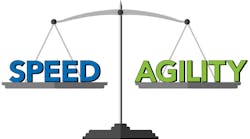The Key to Balancing Speed, Agility in Digital Transformation
Raleigh, NC—Quad Graphics, a $4.5B printing and distribution company established in 1971, built its success on a nearly maniacal focus on process.
Speaking at the Manufacturing & Technology Conference, CIO Steve Jaeger began his talk on his company’s digital transformation by pointing out that early in the 1970s the company put PLCs on presses to measure gas and ink consumption. They were also measuring paper thickness. “We were doing IoT before anyone coined the term IoT,” he noted.
But as Quad Graphics began to diversify and make acquisitions—culminating in the takeover of a competitor with 68 different facilities, it found itself coping with different systems, different cultures, and in some cases no standard processes or measurements in place.
“When you’re a greenfield operation, you can establish and maintain common processes, common systems, and a common culture. But we were up against a situation where we no longer had that luxury. It would be cost prohibitive to put in all new systems. We had to ask ourselves if there were a way that we could use business process management (BPM) to improve, digitize, and standardize on our processes,” explained Jaeger.
Looking to go narrow and deep, an area the company immediately focused on was the invoicing of customers. It’s well understood in the business that streamlining the order-to-cash cycle while improving the timeliness of invoices and payment will ultimately accelerate cash flow.
“Coming from our greenfield, organic roots, we were averaging 3-4 days tops, but company-wide the average was 17 to 18 days from production to actually generating the invoice,” explained Jaeger. “Our CFO told us we had to fix that.”
The potential payoff? The CFO estimated that every day the invoicing process could be speeded up would net $10M per day. “Free cash flow is all about agility and speed,” noted Jaeger. “We liked agile because it’s about velocity, and we know that it can lead to higher profits.”
For this initiative, Quad Graphics partnered with Pegasystems, which provides software for operational excellence and customer engagement. As a first step, the team had to map its current processes.
“Automating chaos isn’t good for anyone,” said Jaeger. “Documenting your current process makes you rethink everything and you’re going to find out that some things you are doing don’t even make any sense. It seems that you can always find a better way.”
The results were, in a word--stunning. In the first year of the project, the company reaped an additional $154M in cash flow; two years later in 2017, the number grew to $246M. “We are averaging two days now from production to invoicing, and clients are paying us in an average of four days,” said Jaeger. “And I think we still have a little room to improve.”
That’s not all. Jaeger said that not only has it had a heavy impact on the balance sheet, the process improvements have improved employee satisfaction by eliminating some of the simple, mundane work, like fixing errors. It’s also created transparency across the enterprise, which is a crucial step to future improvements.
For example, Quad Graphics is extending BPM to look at orders across all facilities in order to assign jobs based on priority and availability of production capacity—not something that could be done without transparency.
Next up? AI technology applied to predictive maintenance, where the company is already leveraging the vast amounts of data it collects to predict when a web will break. “There’s still a lot of hype around AI, but it’s real and it’s not going away,” said Jaeger. “




